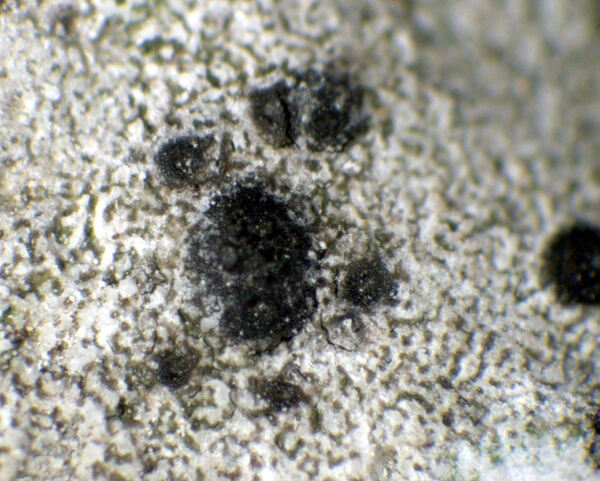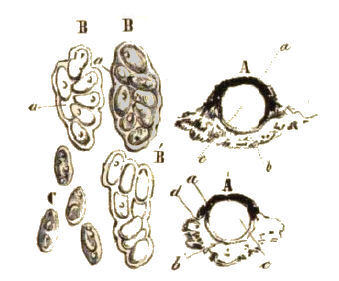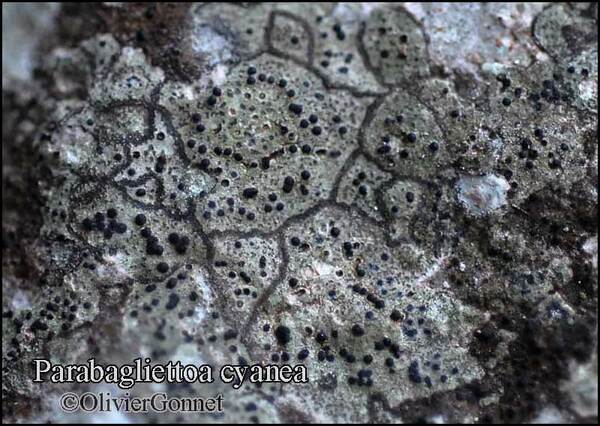Parabagliettoa cyanea (A. Massal.) Gueidan & Cl. Roux
Taxon, 58: 195, 2009. Basionym: Verrucaria cyanea A. Massal. - Mem. Lichenogr.: 144, 1853.
Synonyms: Involucrothele limitata (Nyl.) Servít; Thelidium limitatum (Nyl.) Servít; Verrucaria decussata Garov.; Verrucaria limitata (Nyl.) Kremp.
Distribution: N - VG, Frl (TSB 3746), Ven (Lazzarin 2000b, Watson 2014), TAA (Nascimbene & al. 2022), Lomb, Piem (Isocrono & al. 2004), Emil (Bouvet 2008, Fariselli & al. 2020), Lig. C - Tosc (Benesperi 2006), Laz (Nimis & Tretiach 2004), Mol (Garofalo & al. 1999, Genovesi & Ravera 2014), Sar. S - Camp (Garofalo & al. 1999, 2010, Aprile & al. 2003b), Pugl (Nimis & Tretiach 1999), Si (Nimis & al. 1994, Caniglia & Grillo 2005, 2006, Grillo & al. 2007b, Liistro & Cataldo 2011).
Description: Thallus crustose, endosubstratic to hemiendosubstratic in older parts, whitish to pale grey, with numerous, up to 100 μm wide flecks, smooth, delimited from adjacent conspecific thalli by sunken to slightly raised, single or double brown lines, the whole forming a clear mosaic. Pseudocortex formed by a thin prosoplectenchyma intermingled with microcrystals, sometimes with an upper layer of slightly pigmented cortical cells; medulla prosoplectenchymatous, white, K/I+ violet, without macrosphaeroids. Perithecia black, immersed in the rock with only the black apex visible, or forming black projections 0.2-0.35 μm across, sometimes forming poorly defined pits in the rock. Involucrellum confined to apex of exciple or spreading sideways and downwards up to c. mid-level; exciple colourless to brown; hamathecium of periphyses and periphysoids, interascal filaments absent; hymenial gel hemiamyloid, I+ red (I+ blue at very low concentrations of I), K/I+ blue. Asci 8-spored, clavate, I-, fissitunicate, the wall thickened above, with an ocular chamber, dehiscent by extrusion of an endotunica to form a delicate rostrum, Verrucaria-type. Ascospores 1-celled, hyaline, ellipsoid (12-)15-20 x 6-9 μm. Photobiont chlorococcoid. Spot tests: K-, C-, KC-, P-, UV-. Chemistry: without lichen substances.Note: on steeply inclined surfaces of compact limestone and dolomite in sheltered situations; optima in the submediterranean belt (in Northern Italy), and in the montane belt (in Southern Italy), much rarer, and mostly coastal, in shaded-humid situations of the eu-Mediterranean belt. The species differs from P. dufourii in the smaller, less prominent perithecia, and the thalli typically in a mosaic with conspecific thalli, separated by dark lines; the lines produced by one thallus typically do not merge completely with that of its neighbour, so the lines often appear double (Orange 2013).
Growth form: Crustose endolithic
Substrata: rocks
Photobiont: green algae other than Trentepohlia
Reproductive strategy: mainly sexual
Commonnes-rarity: (info)
Alpine belt: absent
Subalpine belt: absent
Oromediterranean belt: absent
Montane belt: rather common
Submediterranean belt: rare
Padanian area: absent
Humid submediterranean belt: rather rare
Humid mediterranean belt: very rare
Dry mediterranean belt: absent
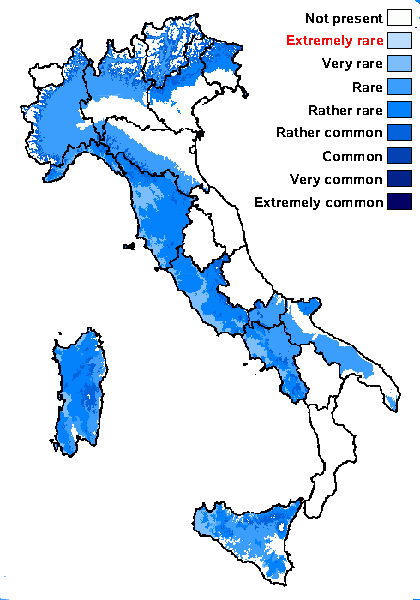
Predictive model
Herbarium samples


P.L. Nimis; Owner: Department of Life Sciences, University of Trieste
Herbarium: TSB (32438)
2002/02/23
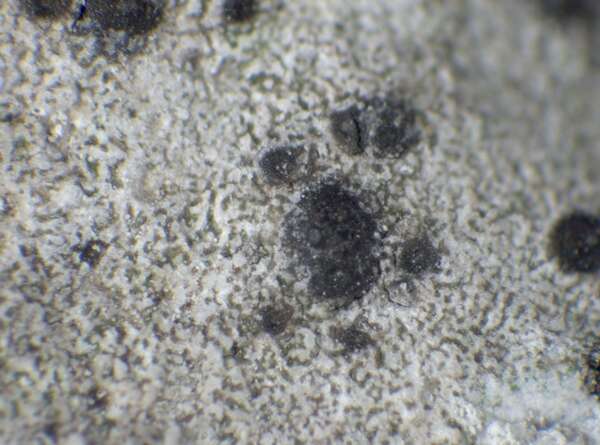

P.L. Nimis; Owner: Department of Life Sciences, University of Trieste
Herbarium: TSB (32438)
2002/02/23
Growth form: Crustose endolithic
Substrata: rocks
Photobiont: green algae other than Trentepohlia
Reproductive strategy: mainly sexual
Commonnes-rarity: (info)
Alpine belt: absent
Subalpine belt: absent
Oromediterranean belt: absent
Montane belt: rather common
Submediterranean belt: rare
Padanian area: absent
Humid submediterranean belt: rather rare
Humid mediterranean belt: very rare
Dry mediterranean belt: absent

Predictive model
| Herbarium samples |


P.L. Nimis; Owner: Department of Life Sciences, University of Trieste
Herbarium: TSB (32438)
2002/02/23


 Index Fungorum
Index Fungorum
 GBIF
GBIF
